Business Sympathy Letter
[Your Name]
[Your Title/Position]
[Your Company/Organization]
[Your Address]
[City, State, ZIP]
[Date]
[Recipient's Name]
[Recipient's Title/Position]
[Recipient's Company/Organization]
[Recipient's Address]
[City, State, ZIP]
Dear [Recipient's Name],
I hope this letter finds you well, though I understand that these may be challenging times for you and your business. I am writing to express my heartfelt sympathy for the recent difficulties your company has faced.
Having heard about the unexpected [mention the specific issue or event, such as financial loss, natural disaster, market downturn, etc.], I can only imagine the toll it must have taken on your team and the broader community that relies on your services. Such circumstances can be incredibly demanding, both professionally and emotionally.
I want you to know that you are not alone during this trying period. As a fellow member of the business community, I understand the unpredictable nature of our industry and the obstacles that can come our way. Please know that I, along with my team at [Your Company Name], stand ready to support you in any way we can.
Whether you need assistance in accessing resources, networking, or simply a listening ear, please do not hesitate to reach out. We believe in the strength of unity among businesses and the importance of helping one another during times of hardship.
Please accept our sincerest condolences for any losses and hardships your company has faced, and let us extend our hand in friendship and solidarity. As you navigate through these challenging times, know that better days lie ahead, and we are here to support you in your journey toward recovery and growth.
Once again, please feel free to contact me at [Your Phone Number] or [Your Email Address]. My team and I are eager to assist in any way possible.
Wishing you strength and resilience during this challenging period.
Sincerely,
[Your Name]
[Your Title/Position]
[Your Company/Organization]
Formal Business Sympathy Letter
Subject: Condolences on Your Loss
Dear [Recipient Name],
We were deeply saddened to hear about the passing of [Name of Deceased]. On behalf of [Company Name], I would like to extend our heartfelt condolences to you and your family during this difficult time.
Please know that our thoughts are with you, and we hope that you find comfort in cherished memories. If there is any way we can support you or your team during this period, please do not hesitate to reach out.
With sincere sympathy,
[Your Name]
[Title]
[Company Name]
Informal Business Sympathy Email
Subject: Thinking of You
Hi [Recipient Name],
I just wanted to reach out and let you know how sorry I am for your loss. Please know that we’re thinking of you during this challenging time.
If there’s anything we can do to support you, please don’t hesitate to ask.
Take care,
[Your Name]
Heartfelt Business Condolence Letter
Subject: Heartfelt Condolences
Dear [Recipient Name],
I was deeply saddened to hear about the passing of [Name of Deceased]. Please accept our heartfelt condolences. Your loss is felt deeply by all of us at [Company Name].
May the love and support of colleagues and friends bring you some comfort, and may [Name of Deceased]’s memory be a blessing to all who knew them.
Warm regards,
[Your Name]
[Title]
[Company Name]
Quick Sympathy Message to a Business Partner
Subject: Condolences
Dear [Recipient Name],
We are sorry for your loss. Our thoughts are with you and your family at this time. Please let us know if we can be of any support.
Sincerely,
[Your Name]
Formal Letter Expressing Sympathy After Employee Loss
Subject: Condolences on the Loss of a Team Member
Dear Team,
It is with great sadness that we acknowledge the passing of [Employee Name]. We extend our deepest sympathy to their family, friends, and colleagues.
We encourage everyone to support each other during this difficult time and remember the positive impact [Employee Name] had on our organization.
With deepest sympathy,
[Your Name]
[Title]
[Company Name]
Professional Sympathy Email to a Client
Subject: Our Condolences
Dear [Client Name],
We were saddened to learn about your recent loss. On behalf of [Company Name], please accept our sincere condolences. We hope you and your family find strength during this time.
Please do not hesitate to reach out if there is anything we can assist with.
Kind regards,
[Your Name]
[Title]
[Company Name]
What is a Business Sympathy Letter and Why It Is Important
- A formal or semi-formal written expression of condolences in a professional context
- Shows respect, empathy, and professionalism
- Helps maintain good relationships with clients, colleagues, or business partners
- Provides a record of communication for sensitive matters
Who Should Send a Business Sympathy Letter
- Company representatives to clients, vendors, or partners
- HR or management to employees or staff families
- Colleagues within a professional team
- Individuals representing the organization in formal capacity
Whom the Business Sympathy Letter Should Be Addressed To
- Directly to the bereaved employee, client, or business associate
- Optionally to family members if appropriate and known
- CC to relevant team members or company leadership in internal communications
When to Send a Business Sympathy Letter
- Immediately after learning of the death or serious loss
- Within a few days to a week to show prompt acknowledgment
- After funerals or memorial events for follow-up condolences if necessary
How to Write an Effective Business Sympathy Letter
- Begin with a polite and empathetic greeting
- Express condolences sincerely and clearly
- Mention the deceased by name where appropriate
- Offer support or assistance if feasible
- End with a formal closing and signature
Formatting Guidelines for Business Sympathy Letters
- Tone: Formal, respectful, and empathetic
- Length: Short and concise, typically 150–250 words
- Style: Professional with a touch of heartfelt sentiment
- Mode: Email for quick communication; printed letter for formal or traditional contexts
- Include subject line (if email), salutation, body, closing, and signature
Requirements and Prerequisites Before Sending a Sympathy Letter
- Accurate information regarding the loss or bereavement
- Correct recipient names and titles
- Understanding of the relationship between sender and recipient
- Sensitivity to timing and appropriateness of the message
After Sending a Business Sympathy Letter
- Follow up only if appropriate, e.g., to offer further support
- Respect the recipient’s privacy and grieving process
- Document the communication in company records if required
- Avoid excessive or repeated messages
Common Mistakes to Avoid in Business Sympathy Letters
- Being overly casual or using inappropriate humor
- Delaying sending the letter for too long
- Including unnecessary or intrusive personal opinions
- Making promises that cannot be fulfilled
Elements and Structure of a Business Sympathy Letter
- Salutation: Address recipient respectfully
- Opening line: Express condolences
- Body: Mention the deceased and acknowledge the loss
- Offer of support: Optional but recommended
- Closing: Formal and empathetic sign-off
- Signature: Name, title, and organization
Tips and Best Practices for Business Sympathy Letters
- Keep the message sincere and concise
- Avoid overused clichés; personalize where possible
- Use correct spelling and professional language
- Follow up with appropriate support if relevant
- Send promptly to show attentiveness and care
Compare and Contrast with Personal Sympathy Letters
- Personal letters can be more emotional and intimate
- Business letters should maintain professionalism while being empathetic
- Similarity: Both convey condolences and support
- Difference: Business letters avoid excessive personal detail and maintain professional boundaries
Pros and Cons of Sending a Business Sympathy Letter
Pros:
- Strengthens professional relationships
- Demonstrates empathy and corporate responsibility
- Maintains organizational reputation
Cons:
- Risk of appearing insincere if poorly worded
- May require careful handling of sensitive relationships
- Potentially uncomfortable if sender is not close to recipient


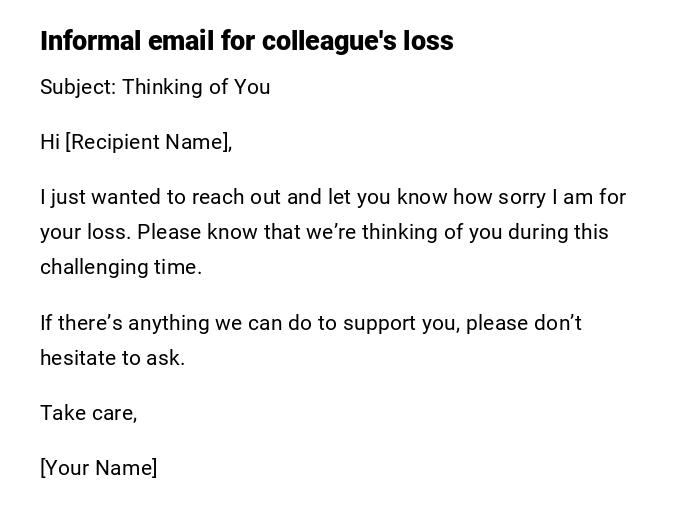
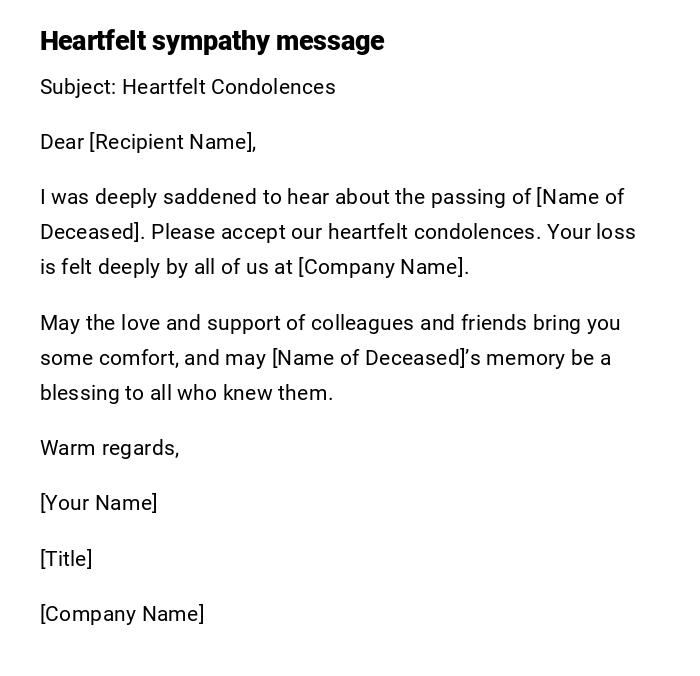
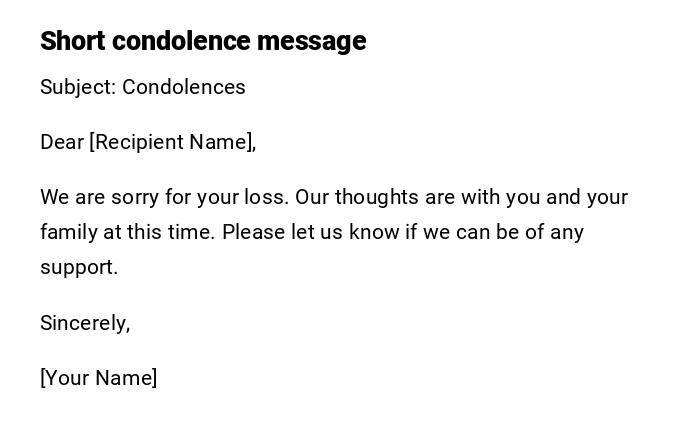
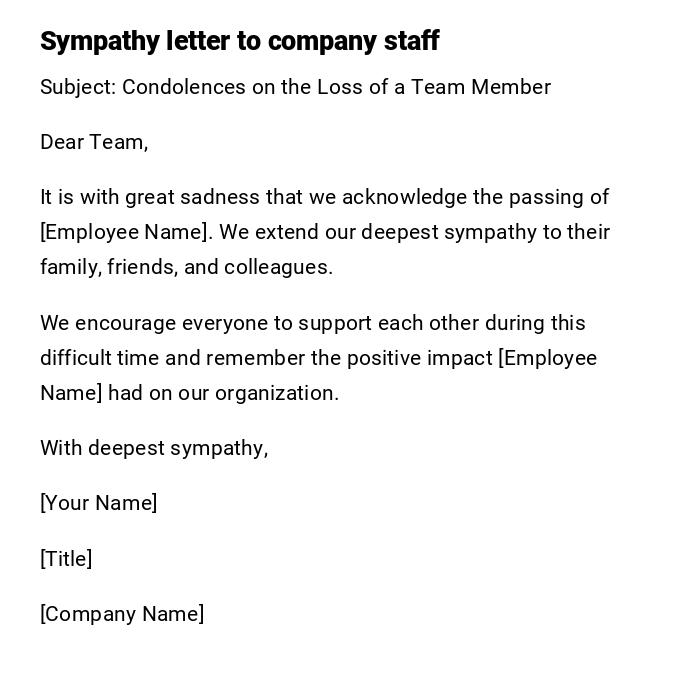
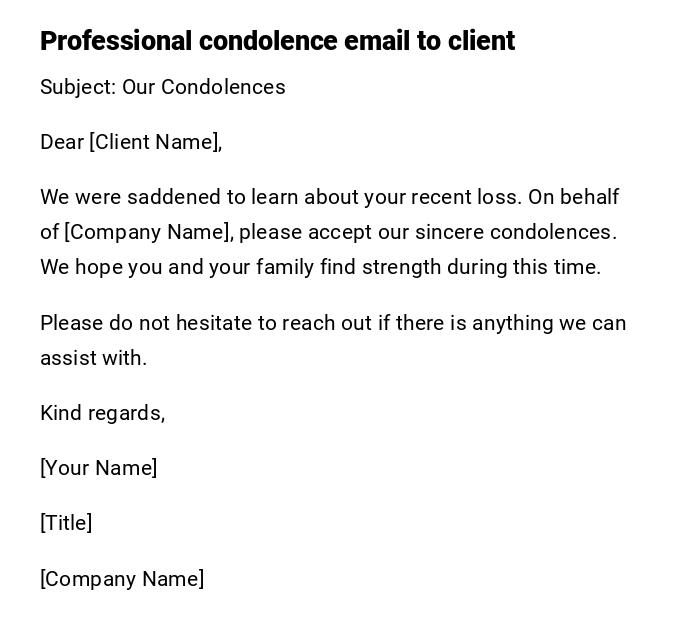

 Download Word Doc
Download Word Doc
 Download PDF
Download PDF